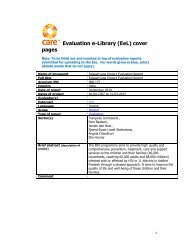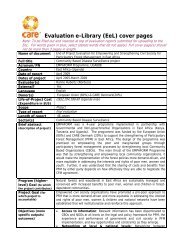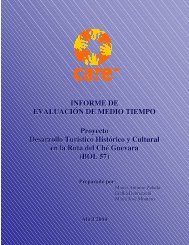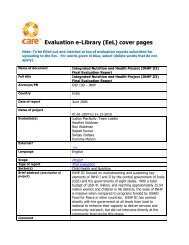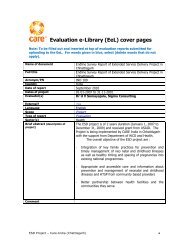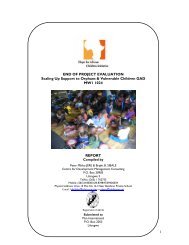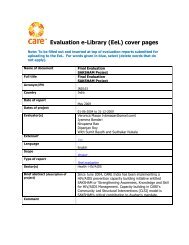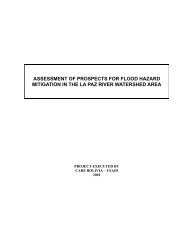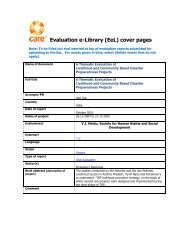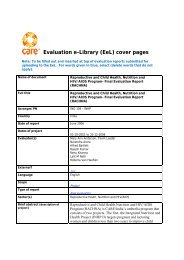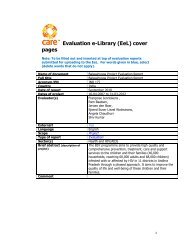IND 199 ECDE Baseline - CARE International's Electronic ...
IND 199 ECDE Baseline - CARE International's Electronic ...
IND 199 ECDE Baseline - CARE International's Electronic ...
- No tags were found...
You also want an ePaper? Increase the reach of your titles
YUMPU automatically turns print PDFs into web optimized ePapers that Google loves.
lviiiAll the respondents under the survey were asked whether they knew about dowry prohibitionact and if yes, they were further questioned what they knew about it, Table 6.5 provides theirresponses.Table 6.5: Knowledge of mothers/caregivers about Dowry Prohibition Act, 1961 and 2004(Percentage)Particulars Intervention districts Control districtInterventionAWCsIntermediateAWCsControl AWCsAwareness of dowry prohibitionact, 1961 & 2004 (n=) 828 844 924Yes 32.5 30.8 57.8No 67.5 69.2 42.2Knowledge about the act (n=) 269 260 534Any form of abuse causing harm orinjury to the physical and / or mentalhealth of the woman or compromisingher life and safety 54.3 51.2 84.5Any harassment for dowry or to meetany other unlawful demand 63.6 58.5 63.5Threat to cause injury or harm 47.6 52.3 47.9Prohibits giving or taking of dowry 61 61.5 31.6The main findings are as follows:• About one – third of percent of the respondents in intervention districts (48% in Janjgirand 14% in Kobra) and 58 percent in control district expressed their awareness of the act.• About three - fifths of them in intervention districts each reported that the act prohibits“any harassment for dowry or to meet any other unlawful demand” and “giving or takingof dowry; with vast variation across the study intervention districts. The correspondingfigures of such respondents in control district were 63 percent and 32 percent respectively.• About 53 percent of them in intervention districts ( 43% in Janjgir and 85% in Korbadistrict) and 84 percent in control district reported that “the dowry act does not permit anyform of abuse causing harm or injury to the physical and / or mental health of the womanor comprising her life and safety”• Slightly less than one – half of them in both intervention and control district; with vastvariation across the study intervention districts expressed that the act does not permit“any threat to cause injury or harm to woman”.77 6.6 Domestic violence act , 2005 for women• Regarding awareness of domestic violence act, about 24 percent in intervention districts(32% in Janjgir and 14% in korba district) were aware of it. The proportion of suchrespondents was higher in control district (56%) (Table 6.6).• Almost all of them knew that the act prevents violence against women at home (Table6.6).<strong>Baseline</strong> Study Of Early Childhood Care And Development Project In ChattisgarhApril,2012



